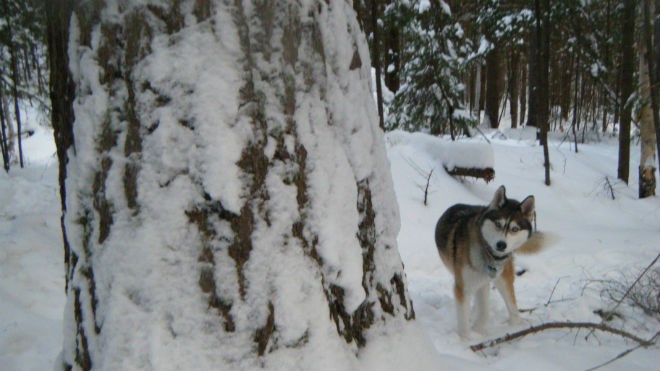The snowshoeing has been great this winter.
There is just enough snow to make it worthwhile putting the 'shoes on, but not so much as to make it hard to get around. This is the very best way to see the world of winter. Little equipment is needed, no trails required, there are only a few limits to where you can go … like over cliffs.
This year, I have been exploring the peninsula that runs up the middle of the lake. A half kilometer wide in places, and three kilometers long, it could take most of February to see it all.
Mostly I am interested in the ancient pines. I can see them from my window, rising above the rest of the forest below.
This week, I wanted to find the big trees near the northern tip of the peninsula. A dozen of them can clearly be seen from home. On a very cold day, the bright sun above and lack of wind allowed a pleasant crossing of the wide-open space of the lake.
I entered the forest through a narrow gap between the cedars at the shoreline. Pushing through the aromatic branches, it didn’t take very long to get through to easy walking under the poplar and pine. Focusing on the white pines, I wandered here and there, trying to figure out which trees were the ones I can see from home.
Now and then I saw remnants of the old forest. There were ancient white pine snags, 10 to 30 feet high and charred through the middle.
The first of the red and white pines I found were very beautiful, but not very old. I reminded myself that the lake had been thoroughly logged about a hundred years ago. These scattered pines would be younger than that.
I continued my trek up the hill. Visiting this pine and that, I found a few that were bigger than the others, but still in their youth. They were very tall. Were these the trees I was looking for?
The hill seemed to keep rising. I clambered over fallen balsams, through a little valley of cedar and spruce, and upward again. Looking up to the crowns to find the next big pine, my path continued to wander.
Over to the left, one of the white pines had a very large branch about two-thirds of the way up. That must be a bigger tree, I thought. Indeed it was. It did not take very long to find the next big tree, and the next.
From a distance, they looked just like the younger trees. I had to get close to see how big they really were. Most would need two people to hug them all the way around.
I found what I was looking for. But how could I tell from below which of these were the trees I saw from home?
One of the bigger white pines has a dead red pine at its side. Probably killed by lightning. This would be my marker. When I got home, I hoped to find this location through the binoculars.
One day I will be old, looking out the window at this forest. I’ll cozy up in a comfy chair, gaze upon these trees, and remember the treks I made to visit them in person.
Viki Mather has been commenting for Northern Life on the natural world and life in Greater Sudbury since the spring of 1984.
Join Sudbury.com+
- Messages
- Post a Listing
- Your Listings
- Your Profile
- Your Subscriptions
- Your Likes
- Your Business
- Support Local News
- Payment History
Sudbury.com+ members
Already a +member?
Not a +member?
Sign up for a Sudbury.com+ account for instant access to upcoming contests, local offers, auctions and so much more.
